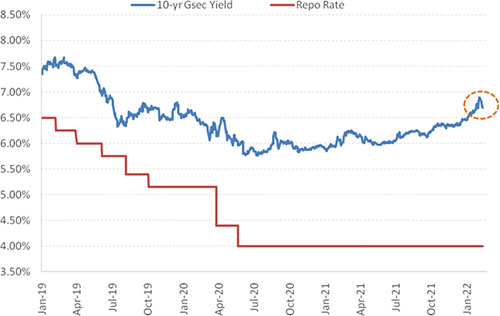The Debt Mutual Fund Investment Strategy to Follow after RBI’s Recent Monetary Policy Meeting
Divya Grover
Feb 14, 2022
Listen to The Debt Mutual Fund Investment Strategy to Follow after RBI’s Recent Monetary Policy Meeting
00:00
00:00
The RBI's Monetary Policy Committee (MPC) left the policy repo rate and reverse repo rate unchanged at 4% and 3.35%, respectively, during its February 2022 meeting. Meanwhile, it also maintained its accommodative stance to support economic growth. This was the tenth consecutive time that the RBI has left interest rates unchanged.
Many debt mutual fund managers and debt market experts did expect the RBI to marginally hike the reverse repo rate, change the policy stance from accommodative to neutral, and announce plans for the eventual hike in repo rate during its February meeting. However, the MPC unanimously decided to maintain the status quo even as its counterparts in the US and other countries have announced plans to hike interest rates and trim excess liquidity.
RBI's status quo came as a relief for debt mutual funds, especially those with longer duration portfolios, as yields on government securities saw a sharp drop. Debt mutual fund schemes across durations witnessed a rise in their Net Asset Value (NAV) since bond prices and yield are inversely related.
Notably, bond yields that rose steadily over the past few months shot up sharply after announcement of the Union Budget for the financial year 2022-23. The government announced higher-than-anticipated borrowing program and that led to a steep rise in bond yield. Consequently, the NAV of debt mutual funds across categories, except Liquid funds and Overnight Funds, suffered erosion.
Graph: The 10-year G-Sec yield fell after RBI kept interest rates unchanged
 Data as on February 11, 2022
Data as on February 11, 2022
(Source: in.investing.com)
Why did RBI maintain status quo?
The RBI kept policy rates unchanged to support economic growth amid the uncertainties caused by the highly contagious Omicron variant. According to the RBI, even though the Omicron symptoms have remained relatively mild and the pace of infections is moderating, there has been some loss of momentum in economic activity as reflected in high frequency indicators such as purchasing managers' indices for manufacturing and services, finished steel consumption, and sales of tractors, two wheelers and passenger vehicles. The demand for contact-intensive services is still muted.
Moreover, RBI seemed comfortable with the inflation readings even as global central banks are seeing it as cause for concern and a reason to fast track rate hikes. This is because India's domestic inflationary pressures are different from those the global central banks face.
 Image source: www.freepik.com
Image source: www.freepik.com
Mr Michael Patra, RBI's Deputy Governor and Economist, interacting with the media said that inflation in the US is being driven by used car prices, which are at multi-decade highs; this is not a problem in India. In the case of parts of Europe, the shortage of truck drivers is hurting supplies and impacting wage rises and inflation. India's food inflation is estimated at around 3% while in the US, it is near 6.5%.
The RBI expects headline inflation to peak in Q4:2021-22 within the tolerance band and then moderate closer to target in H2:2022-23, thereby providing room for monetary policy to remain accommodative. It has stated that improving prospects for the production of foodgrains and the expected easing of vegetable prices on fresh winter crop arrivals are adding optimism for CPI to move in alignment with the projection. Though RBI has stated that hardening of crude oil prices presents a major upside risk to the inflation outlook, it expects that the continuing pass through of tax cuts relating to petrol and diesel last November would help to moderate input cost pressures to some extent.
The way ahead for interest rates and its impact on debt mutual funds
Interest rates are currently at a multi-year low and appear to have bottomed out. Despite RBI's decision to keep interest rate unchanged for now, it would not have much leeway to continue to do so in the coming financial year. However, the extent and pace of the rate hike will depend on various factors, mainly inflation and domestic economic recovery.
Besides, the debt market is expected to remain volatile due to government's higher borrowing programme, geo-political tensions, elevated crude oil prices, and uncertainties due to the pandemic. Therefore, debt mutual fund investors need to tread with caution.
As mentioned earlier, bond price and interest rates are inversely related, when interest rates go up, the prices of bonds fall. As a result, the net asset value of debt funds also declines. Schemes that have higher allocation to securities with longer durations are more sensitive to changes in interest rate and may witness a decline in NAV when the interest rates start to rise.
What should be your Debt Mutual Fund Investment Strategy now?
Given that the rate hike is imminent, it would be prudent to invest in debt mutual funds that are less inclined towards longer duration instruments and set their focus on the shorter end of the yield curve. Debt mutual funds that invest in the short maturity segment witness minimal mark-to-market impact when interest rates rise. Accordingly, investors should consider investing in funds having a higher allocation to shorter maturity instruments, such as Liquid Funds, as they would carry less interest rate risk once interest rates change direction and start moving upwards.
The lower residual maturity helps the fund to follow an accrual strategy where it can earn from coupon payments and roll over the assets on maturity. The accrual strategy also helps reduce the impact in a rising interest rate scenario.
Table: How have debt mutual funds performed amid volatile debt market
| Scheme Name |
1 Month (%) |
3 Months (%) |
6 Months (%) |
1 Year (%) |
| Banking and PSU Fund |
0.43 |
0.81 |
1.99 |
4.84 |
| Corporate Bond |
0.50 |
0.82 |
7.21 |
10.59 |
| Credit Risk Fund |
0.83 |
1.42 |
5.38 |
9.83 |
| Dynamic Bond |
0.34 |
0.49 |
2.54 |
5.12 |
| Gilt Fund with 10 year constant duration |
-0.12 |
-0.53 |
0.87 |
2.27 |
| Liquid |
0.27 |
0.82 |
1.59 |
3.15 |
| Long Duration |
0.43 |
-0.40 |
2.51 |
2.23 |
| Low Duration |
0.39 |
1.06 |
8.59 |
11.01 |
| Medium Duration |
0.38 |
0.29 |
2.44 |
4.65 |
| Money Market |
0.31 |
0.94 |
1.85 |
3.87 |
| Overnight Fund |
0.28 |
0.86 |
1.66 |
3.24 |
| Short & Mid Term |
0.36 |
0.28 |
2.02 |
4.03 |
| Short Duration |
0.48 |
0.93 |
2.83 |
5.78 |
| Ultra Short Duration |
0.34 |
1.05 |
2.17 |
4.45 |
| Crisil Composite Bond Fund Index |
0.45 |
0.28 |
2.14 |
4.44 |
| Crisil 1 Yr T-Bill Index |
0.44 |
0.91 |
1.59 |
3.76 |
| Crisil 10 Yr Gilt Index |
-0.52 |
-0.85 |
-0.26 |
0.29 |
Category average returns considered. Returns are Absolute
Data as of February 11, 2021
(Source: ACE MF)
Depending on your financial goals, risk profile, and investment horizon, you can consider investing in debt mutual fund categories, such as Liquid Funds, Ultra Short Duration Funds, Dynamic Bond Funds, Corporate Bond Funds, and Banking & PSU Debt Funds.
Most debt mutual fund schemes, other than those mandated to invest in long term securities, have already reduced the average maturity profile to around 3 years or less in anticipation of rate hikes. Therefore, the impact of a rate hike on such schemes could be lower. So, if you have invested in such schemes you don't need to rejig your portfolio.
But it is important to look at the credit profile of the schemes you are investing in. Even though economic sentiments have improved, avoid investing in schemes that hold higher allocation to moderate and low rated instruments as it can expose you to higher credit risk. Stick to debt mutual funds where the fund manager does not chase yields, but instead focuses on government and quasi-government securities.
Lastly, remember that though debt mutual funds are relatively stable compared to equity mutual funds, you cannot expect guaranteed returns. Therefore, it is important to understand the various risk involved viz. interest rate risk and credit risk before selecting a debt mutual fund for your portfolio; avoid selecting schemes based on its recent performance or star ratings.
If you are looking for quality mutual fund schemes (including Equity-linked Saving Schemes) to add to your investment portfolio, I suggest you subscribe to PersonalFN's premium research service, FundSelect. PersonalFN's FundSelect service provides insightful and practical guidance on which mutual fund schemes to Buy, Hold, and Sell.

Currently, with the subscription to FundSelect, you could also get Free Bonus access to PersonalFN's Debt Fund recommendation service DebtSelect.
If you are serious about investing in a rewarding mutual fund scheme, subscribe now!
Warm Regards,
Divya Grover
Research Analyst
Join Now: PersonalFN is now on Telegram. Join FREE Today to get ‘Daily Wealth Letter’ and Exclusive Updates on Mutual Funds